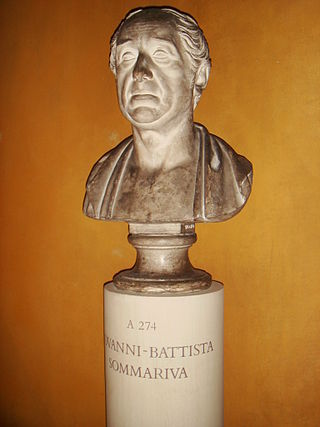Top Qs
Timeline
Chat
Perspective
Giovanni Battista Sommariva
Italian politician From Wikipedia, the free encyclopedia
Remove ads
Giovanni or Gian Battista Sommariva (died 6 January 1826, Milan) was an Italian politician of the Cisalpine Republic and a notable arts patron.

Biography
Summarize
Perspective
Born in 1762 in Sant'Angelo Lodigiano, of a humble family, he eventually became a wealthy barrister. He was living in Milan by 1796 when Napoleon’s army entered the city. Sommariva took the side of the French and he was recruited to become secretary general of the directory of the Cisalpine Republic. In 1799, he fled from Milan to France to escape the armies of Suvorov.[1] He returned to Italy after the Battle of Marengo and was the virtual dictator of Milan from 1800 to 1802, amassing a personal fortune and making many enemies due to his unscrupulous behaviour. When Napoleon replaced him with Francesco Melzi d'Eril, Sommariva turned his attention to building a collection of contemporary art, which he displayed in his villa (now the Villa Carlotta) at Tremezzo on Lake Como.
In 1806 he moved to Paris, bought a town house there, as well as large a country estate at Montmorency, north of the city, and increased his patronage of contemporary artists.[2] He commissioned works from many important French and Italian artists of the early 19th century, including Jacques-Louis David (e.g. Cupid and Psyche, 1817; Cleveland Museum of Art). Sommariva preferred the Neoclassical style and mythological subjects, which often stress the theme of peace and its delights. He was the most important patron in France of Italian sculptors, especially of Antonio Canova, whose Penitent Magdalene (marble, 1794–6; Genoa, Museo di Sant'Agostino) he acquired. He also commissioned engravings and enamels after his paintings for the purpose of advertising his collection and furthering his social ambitions. His liaison with Sophie d'Houdetot placed him within the circle of her influential salon.
Following his death in 1826 his son Luigi Sommariva took part of the Paris collection to the villa on Lake Como, where he continued to add to it. After Luigi’s death in 1838 most of the paintings and sculptures remaining from his father’s collection in Paris, including many copies of Old Master paintings, were auctioned by Luigi’s widow. Three paintings by Pierre-Paul Prud'hon set record prices at auction; another painting, Transported by Zephyrs (1808), was donated to the Louvre.
Remove ads
References
Bibliography
Wikiwand - on
Seamless Wikipedia browsing. On steroids.
Remove ads
